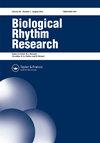Potential linkages between circadian rhythm and membrane lipids: timekeeper and bilayer
IF 0.9
4区 生物学
Q3 BIOLOGY
引用次数: 1
Abstract
ABSTRACT Membrane lipids play significant roles in cellular functions, including those controlled by circadian machinery (e.g., membrane transport). Membranes have been overlooked during the investigation of circadian mechanisms. The findings of previous studies suggest that membrane action potentials and phospholipid composition exhibit daily oscillations, which involve changes in fatty acid saturation and chain length, and are subjected to fatty chain remodeling. Thus, it is possible that membranes are affected by oscillatory output rhythms from cellular autonomous clocks. The regulation of lipid chain length and degree of unsaturation, along with resulting changes in membrane lipid polymorphic properties, may serve as the basis of an important mechanism that mediates the circadian regulation of various membrane-associated processes. However, direct evidence indicating that membrane lipid oscillations are part of the circadian machinery has yet to be reported. This review updates the current understanding of potential connections between the membrane bilayer and the circadian clock, with important implications for circadian rhythm disorders and related chronic diseases, such as obesity, diabetes, and cardiovascular disease.昼夜节律和膜脂之间的潜在联系:计时器和双层
膜脂在细胞功能中发挥着重要作用,包括那些由昼夜节律机制控制的功能(如膜运输)。在昼夜节律机制的研究中,膜一直被忽视。以往的研究结果表明,细胞膜的动作电位和磷脂组成呈现出每日振荡,这涉及脂肪酸饱和度和链长度的变化,并受到脂肪链重构的影响。因此,膜可能受到来自细胞自主时钟的振荡输出节律的影响。脂链长度和不饱和程度的调节,以及由此导致的膜脂多态性特性的变化,可能是介导各种膜相关过程昼夜节律调节的重要机制的基础。然而,直接证据表明膜脂振荡是昼夜节律机制的一部分还没有报道。这篇综述更新了目前对膜双分子层和生物钟之间潜在联系的理解,对昼夜节律紊乱和相关慢性疾病(如肥胖、糖尿病和心血管疾病)具有重要意义。
本文章由计算机程序翻译,如有差异,请以英文原文为准。
求助全文
约1分钟内获得全文
求助全文
来源期刊

Biological Rhythm Research
生物-生理学
CiteScore
3.00
自引率
9.10%
发文量
34
审稿时长
6-12 weeks
期刊介绍:
The principal aim of Biological Rhythm Research is to cover any aspect of research into the broad topic of biological rhythms. The area covered can range from studies at the genetic or molecular level to those of behavioural or clinical topics. It can also include ultradian, circadian, infradian or annual rhythms. In this way, the Editorial Board tries to stimulate interdisciplinary rhythm research. Such an aim reflects not only the similarity of the methods used in different fields of chronobiology, but also the fact that many influences that exert controlling or masking effects are common. Amongst the controlling factors, attention is paid to the effects of climate change on living organisms. So, papers dealing with biometeorological aspects can also be submitted.
The Journal publishes original scientific research papers, review papers, short notes on research in progress, book reviews and summaries of activities, symposia and congresses of national and international organizations dealing with rhythmic phenomena.
 求助内容:
求助内容: 应助结果提醒方式:
应助结果提醒方式:


